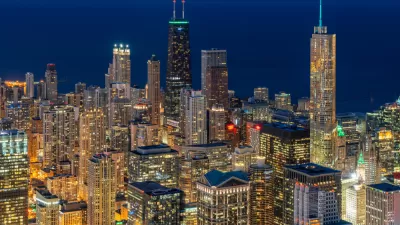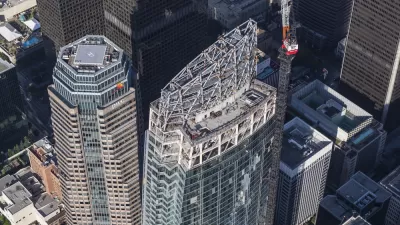The Council on Tall Buildings and Urban Habitat has released its annual report on the state of skyscraper construction. Worldwide, 2012 witnessed the completion of 66 buildings taller than 200 meters, including the second tallest in the world.
Though tall building construction lulled for the first time in 6 years, it is expected to rise in 2013 and 2014. Milestones over the past year included the completion of the Makkah Royal Clock Tower Hotel in Saudi Arabia, now the second tallest building in the world and one of the world's two 'megatall' structures, at 601 meters. Also, four of the six tallest buildings completed in 2012 are located in Dubai. In addition, China built 22 buildings over 200 meters tall, representing about one third of the global number. And, Mecca saw the completion of five buildings taller than 200 meters (in the entire U.S. only two were completed). Finally, 12 of the 66 tall buildings finished in 2012 made it onto the list of the Top 100 tallest buildings worldwide.
So why all this building up? According to the latest 'Tall Trends of 2012' report [PDF], there are several factors driving this upward spiral including, "[t]he limited availability of land in urban centers, [which] is driving up prices and prompting developers to build taller to recoup their investments." Furthermore, "[s]everal countries, including China, are also in the midst of a dramatic shift from rural to urban economies." And, "[i]n addition, new technologies and building systems are increasing the efficiency of tall buildings, allowing developers to cost-effectively create taller projects.” Another driving factor is a “sharp increase in prices for luxury apartments,” which translated into the inclusion of residential components in many of these skyscrapers.
China's building boom is expected to last for years, and Canada, with Toronto as its “epicenter”, is now the “hot spot for tall building development” in North America. The article concludes: "Despite the economic crisis, tall building construction is still an important driver for the revitalization of fast-growing urban centers around the world, particularly in Asia and the Middle East... The need to create efficient, high density districts for people to live and work is pushing skylines higher, and there is no evidence that those factors will subside any time soon."
FULL STORY: Year in Review: Tall Trends of 2012

Planetizen Federal Action Tracker
A weekly monitor of how Trump’s orders and actions are impacting planners and planning in America.

Maui's Vacation Rental Debate Turns Ugly
Verbal attacks, misinformation campaigns and fistfights plague a high-stakes debate to convert thousands of vacation rentals into long-term housing.

San Francisco Suspends Traffic Calming Amidst Record Deaths
Citing “a challenging fiscal landscape,” the city will cease the program on the heels of 42 traffic deaths, including 24 pedestrians.

Defunct Pittsburgh Power Plant to Become Residential Tower
A decommissioned steam heat plant will be redeveloped into almost 100 affordable housing units.

Trump Prompts Restructuring of Transportation Research Board in “Unprecedented Overreach”
The TRB has eliminated more than half of its committees including those focused on climate, equity, and cities.

Amtrak Rolls Out New Orleans to Alabama “Mardi Gras” Train
The new service will operate morning and evening departures between Mobile and New Orleans.
Urban Design for Planners 1: Software Tools
This six-course series explores essential urban design concepts using open source software and equips planners with the tools they need to participate fully in the urban design process.
Planning for Universal Design
Learn the tools for implementing Universal Design in planning regulations.
Heyer Gruel & Associates PA
JM Goldson LLC
Custer County Colorado
City of Camden Redevelopment Agency
City of Astoria
Transportation Research & Education Center (TREC) at Portland State University
Jefferson Parish Government
Camden Redevelopment Agency
City of Claremont




























